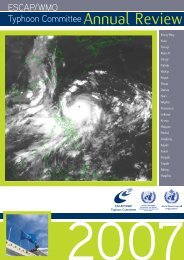TCAR - Typhoon Committee
TCAR - Typhoon Committee
TCAR - Typhoon Committee
Create successful ePaper yourself
Turn your PDF publications into a flip-book with our unique Google optimized e-Paper software.
Fig. 31. Expert Mission in Da Nang<br />
Fig. 32. Expert mission in Ho Chi Minh<br />
5. Progress on Key Result Area 5: Strengthened<br />
Resilience of Communities to <strong>Typhoon</strong>-related<br />
Disasters. (List progress on the Strategic Goals<br />
and Associated Activities in the Strategic Plan<br />
and progress on the 2009 <strong>Typhoon</strong> <strong>Committee</strong><br />
Annual Operating Plan goals)<br />
a. Meteorological Achievements/Results<br />
-N.A.<br />
b. Hydrological Achievements/Results<br />
- N.A.<br />
c. Disaster Prevention and Preparedness<br />
Achievements/Results<br />
- N.A.<br />
g. Research, Training, and Other Achievements/<br />
Results<br />
Opening of the UNISDR Education and Training<br />
Institute, UNISDR Northeast Asia Office for<br />
Urban Risk Reduction<br />
The government of the Republic of Korea is<br />
establishing strategies and plans for climate<br />
change response viewing the next 2-3 years as<br />
the crucial and defining moment. After signing<br />
<strong>TCAR</strong><br />
CHAPTER 1 - TYPHOON COMMITTEE ACTIVITIES<br />
an MOU with the United Nations, NEMA opened<br />
the Office for Urban Risk Reduction and the<br />
ISDR Education and Training Institute on 11<br />
August 2009. The ISDR Education and Training<br />
Institute for Urban Risk Reduction is the first<br />
United Nations educational and research facility<br />
for professional urban planners, city managers<br />
and officials of local authorities in the field of<br />
disaster risk reduction. It will cultivate, establish,<br />
and vitalize networks of Disaster Risk Reduction<br />
specialists through extensive education and<br />
training of disaster-related government officials<br />
and NGO officers worldwide. It will also help<br />
science and technology sharing for disaster risk<br />
reduction and stimulate the exchange of disasterrelated<br />
information and data. Simultaneously, it<br />
is expected to help propel Korea’s high-tech IT<br />
DRR technologies and Green Growth industry<br />
onto the international stage.<br />
With official operations scheduled to start in 2010,<br />
NIDP organized two pilot training programs in<br />
September and November based on survey<br />
of trainee demands from various countries.<br />
NIDP plans to operate the Institute like no other<br />
existing institutes by introducing a new form of<br />
special support educational program to maximize<br />
2009<br />
109

















